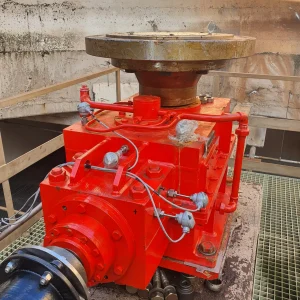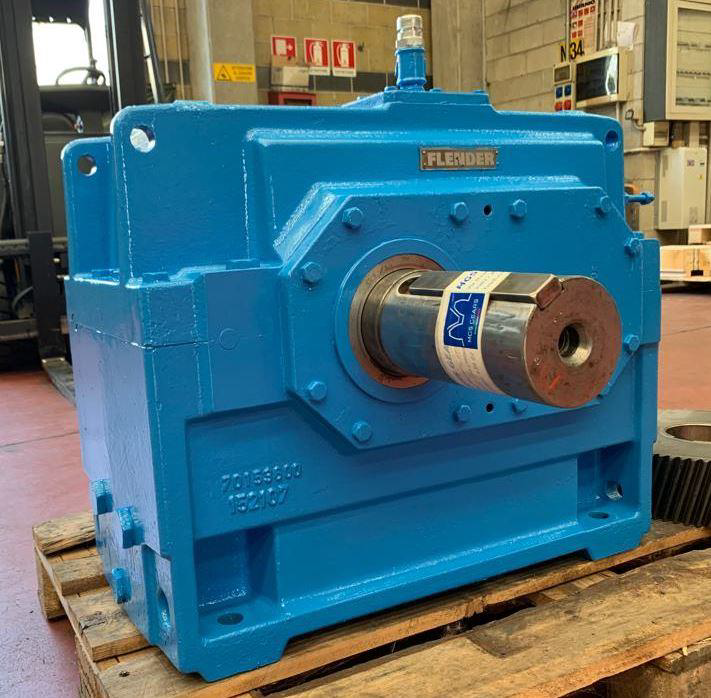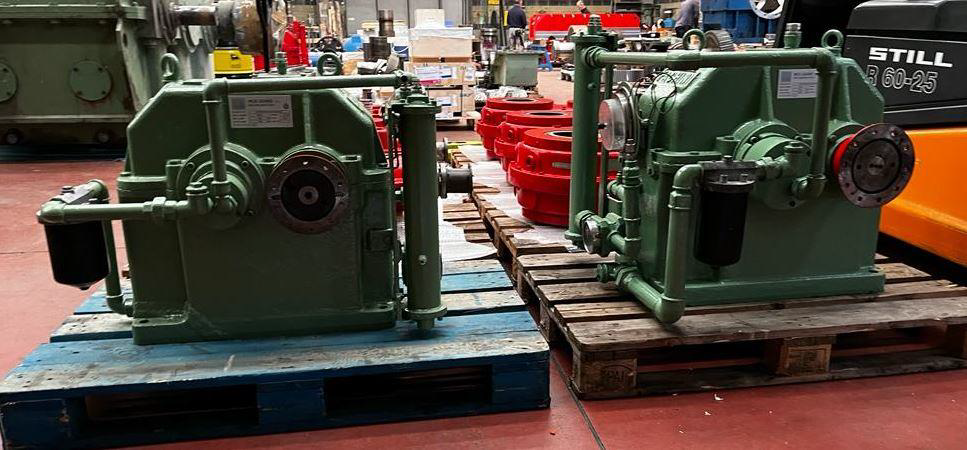Operation Background
Cementos Santo Domingo, S.A., specializes in the grinding and shipping of cement for use in the construction sector. The plant has a Portland-type cement milling process, possible through an Allis Chalmer Ball Mill composed of two chambers 3.35 m in diameter and 9.75 m in length with an 80 Ton/h capacity. The existing girth gear, manufactured by Falk had been used prior to being installed at the Cementos Santo Domingo plant, wear was present as a result of prior operation period. At the beginning of the year 2000, it was necessary to flip the girth gear to use its unworn face in order to complete the gear life of 20 years of operation.
The customer
Miravalles Geothermal Plant
The Case
ABS Costa Rica and MGS Gears Technical Solution
After a first analysis, ABS Costa Rica detected failures originated in the high-speed bevel gear-pair, probably due to wear, which is common in 90° or bevel right angle catalog gearboxes as the ones initially installed, and proposed their replacement by new gearboxes custom designed and manufactured by its brand MGS based on the technical specifications of the Instituto Costarricense de Electricidad (ICE) with the following criteria and objectives:
Standardize the gearboxes so that they can be installed in two types of cooling tower cells (Miravalles I and Miravalles II cells) and can be interchangeable between the different towers of the plant. This has a positive impact on maintenance cost savings, as it eliminates the duplication of spare parts, reduces inventory, and allows a more efficient assessment of overall performance.
Increase the Service Factor of the new gearboxes. ABS Costa Rica designed and manufactured four custom-made gearboxes, through its brand MGS Gears, with the highest manufacturing quality criteria. A case-hardened and tempered steel alloy was used for the bevel gears to achieve high wear resistance and very high gearing precision, which is essential for reliable operation at 1750 rpm. In addition, its geometry was considerably improved by using a globally recognized manufacturing profile that contributes to standardization and ensures component quality. Stronger, closer to the theoretical and ideal rolling tooth shape, and much smoother and more efficient.
 To improve the reliability and maintenance of the equipment, it was also decided to incorporate monitoring sensors to remotely control its condition about the temperatures of all its bearings to analyze vibrations, oil level, and a series of other conditioning factors that allow establishing complete and real-time control of the condition of the gearbox and all its components. In addition, to achieve greater efficiency in the reception and sharing of data, the monitoring was integrated with the SCADA (Supervisory Control and Data Acquisition) system, which is currently used by ICE to receive and manage all the information generated in the process for supervision, quality control, data storage, etc.
To improve the reliability and maintenance of the equipment, it was also decided to incorporate monitoring sensors to remotely control its condition about the temperatures of all its bearings to analyze vibrations, oil level, and a series of other conditioning factors that allow establishing complete and real-time control of the condition of the gearbox and all its components. In addition, to achieve greater efficiency in the reception and sharing of data, the monitoring was integrated with the SCADA (Supervisory Control and Data Acquisition) system, which is currently used by ICE to receive and manage all the information generated in the process for supervision, quality control, data storage, etc.
Currently, the custom-made MGS gearboxes are installed and fully operational at the Miravalles geothermal power plant.
Standardize the gearboxes so that they can be installed in two types of cooling tower cells (Miravalles I and Miravalles II cells) and can be interchangeable between the different towers of the plant. This has a positive impact on maintenance cost savings, as it eliminates the duplication of spare parts, reduces inventory, and allows a more efficient assessment of overall performance.
Increase the Service Factor of the new gearboxes. ABS Costa Rica designed and manufactured four custom-made gearboxes, through its brand MGS Gears, with the highest manufacturing quality criteria. A case-hardened and tempered steel alloy was used for the bevel gears to achieve high wear resistance and very high gearing precision, which is essential for reliable operation at 1750 rpm. In addition, its geometry was considerably improved by using a globally recognized manufacturing profile that contributes to standardization and ensures component quality. Stronger, closer to the theoretical and ideal rolling tooth shape, and much smoother and more efficient.
How does a geothermal plant work?
The principle of operation of a Geothermal Power Plant is to channel the Earth’s heat to convert it into Electrical Energy. In especially favorable areas, mainly where the Earth’s crust is thinner and more irregular, the “breath” of the Earth is harnessed by an extraction shaft that can reach 3000 meters deep, which allows the natural vapors to rise to the surface and be directed to a turbine.
The turbine transforms the kinetic energy of the high-pressure steam into mechanical motion, which, once transferred to a generator, is converted into electricity. The current is transferred to a transformer, increasing its voltage and distributing it to the grid.
After being used to drive the turbine, the steam is channeled to a condenser (or heat exchanger), which lowers its temperature and transforms it into water. Thanks to a cooling tower, the water temperature is further reduced.
There are two options for the water: either it is used in the condenser, where it contributes to lowering the temperature of the steam, or it is reinjected underground, where it will be converted back into steam and give new life to another production cycle to create new renewable energy.
ABS and MGS GEARS, Technical Excellence for the Heavy Industry
For over 20 years, we have been offering products, and engineering solutions for all types of industrial applications drives using gearboxes and components capable of adapting to any assembly requirement, space availability, required torque and ratio, etc. We count on a wide range of special bearings and power transmission solutions for the RENEWABLES industry to help optimize your production processes and extend the life of your industrial equipment.
The turbine transforms the kinetic energy of the high-pressure steam into mechanical motion, which, once transferred to a generator, is converted into electricity. The current is transferred to a transformer, increasing its voltage and distributing it to the grid.
After being used to drive the turbine, the steam is channeled to a condenser (or heat exchanger), which lowers its temperature and transforms it into water. Thanks to a cooling tower, the water temperature is further reduced.
There are two options for the water: either it is used in the condenser, where it contributes to lowering the temperature of the steam, or it is reinjected underground, where it will be converted back into steam and give new life to another production cycle to create new renewable energy.








